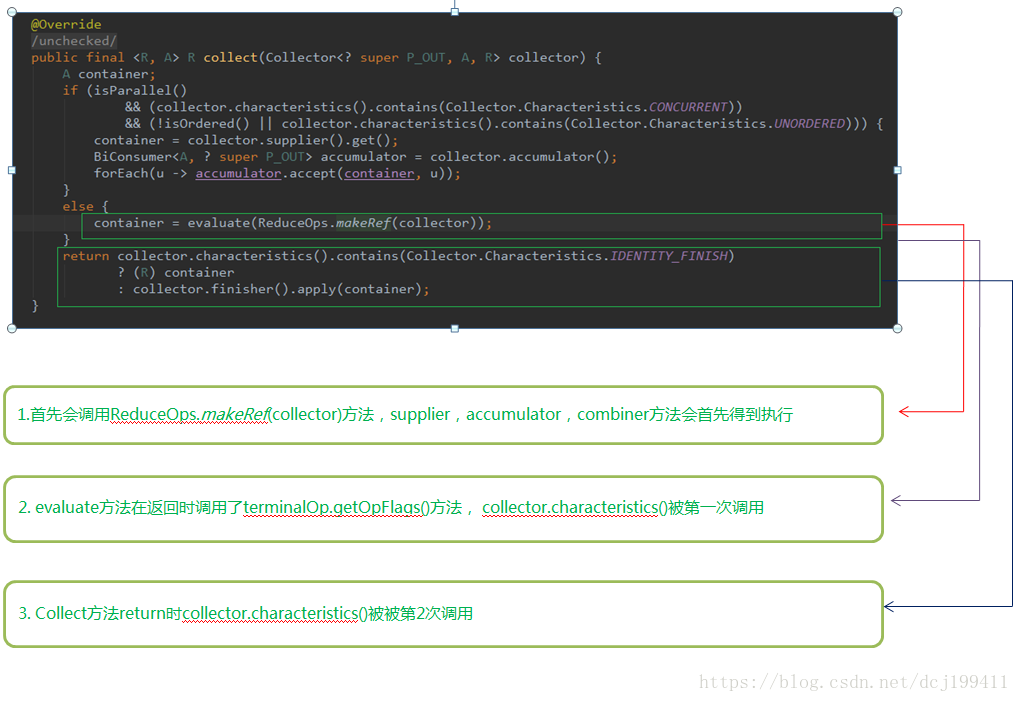1. 接口定义方法
java8接口可以定义default method 和 static method,其中default method供实现该接口的实例调用,static method供类直接调用。
注意点:
- 多个接口默认方法签名相同的问题。
假如有实现类实现了多个含有相同默认方法的接口,这时候编译器会报错, 需要类重写该默认方法。
重写默认方法后,想调用某个接口的默认方法,需要这么写:接口名.super.方法名()调用某个接口的默认方法。
- 实现类的优先级高于接口的优先级
假如一个类C实现了接口I并重写了的默认方法M,类S继承了C并且实现了I, 当类S调用M时,其实调用的是C类种的M方法。
2. 流(Stream)
流管道由三部分组成:
1. 源(可能是数组,集合,生成器函数,I/O通道)
2. 0个或多个中间操作(intermediate operation),它会转换成另外一个流。
3. 终止操作
流是惰性的,当终止操作初始化的时候,流中的元素才会被消费处理。也就是说,只有当流遇到终止操作的时候,流的中间操作的逻辑代码才会执行。
2.1 获取Stream的方式
- Collection接口实现了返回Stream实例的stream方法
- Stream接口的of方法
- Arrays类的静态stream方法
2.2 Stream常用方法
- map方法:接收一个Function,表示一种映射, 是一个中间操作
- distinct方法:针对于流中的元素去重。
- generate方法:接收一个Supplier参数,返回Stream对象
- findFirst(findAny)方法:返回一个Optional对象。
- iterate方法:接收seed和UnaryOperator(Function的特例),返回Stream对象.它一般需要配合Stream.limit方法使用,否则就是一个无限流。
eg:
int res = Stream.iterate(1, item -> item + 2).limit(6).filter(item -> item > 2).mapToInt(item -> item * 2).skip(2).limit(2).sum();- flatMap方法:接收一个Function(接收一个T, 返回R类型的Stream),是中间操作。它是将多个R类型的Stream整合为一个Stream,。
eg:
Stream<List<Integer>> stream3 = Stream.of(Arrays.asList(1,2), Arrays.asList(3,4), Arrays.asList(5));
stream3.flatMap(theList -> theList.stream()).map(i -> i * i).forEach(System.out::println);IntStream类的summaryStatistics方法:它是一个终止操作,返回一个IntSummaryStatistics对象,我们可以取流中的元素的数量,最小值,最大值平均值等等。
Collectors.groupingBy方法: 返回一个Collector对象,用于将流中的元素分组, 它作为Stream对象的collect方法的入参,然后collect方法将会返回一个Map;同时,groupingBy的重载方法也支持二级分组, 将返回Map<T, Map<K,List>>类型的Map对象。
eg:
Student s1 = new Student("zhangsan", 20);
Student s2 = new Student("lisi", 20);
Student s3 = new Student("wangwu", 30);
Student s4 = new Student("zhaoliu", 40);
List<Student> list = Arrays.asList(s1,s2,s3,s4);
Map<Integer, List<Student>> map = list.stream().collect(Collectors.groupingBy(Student::getAge));
System.out.println(map);
System.out.println("====================");
Map<Integer, Long> map2 = list.stream().collect(Collectors.groupingBy(Student::getAge, Collectors.counting()));
System.out.println(map2);
System.out.println("====================");
//二级分组
Map<Integer, Map<String, List<Student>>> map = list.stream().
collect(Collectors.groupingBy(Student::getAge, Collectors.groupingBy(Student::getName)));- Collectors.partitioningByPredicate(<? super T> predicate)方法:用于将流中的元素分区(partition), 它作为Stream对象的collect方法的入参,然后collect方法将会返回一个Map<Boolean,T> 分区是分组的一种特殊情况,相当于永远只返回两个分组。
2.3 Stream总结与注意点
流与集合的区别:集合关注的是数据与数据存储本身,而流关注的是对数据的计算。
流与迭代器的相似点:流不可被重复使用和消费,我们平时的流的方法链式调用都会返回新的Stream对象。
流是短路运算的,只要找到符合条件的值,就不会再去执行。
如下代码的map方法只会输出 item: hello, 虽然单词world的长度也为5,想想为啥?
List<String> list = Arrays.asList("hello", "world", "hello world");
list.stream().map(item -> {
System.out.println("item: " + item);
return item.toUpperCase();
}).filter(item -> item.length() == 5).findFirst().ifPresent(System.out::println);3. 收集器(Collector)
3.1 收集器相关概念
Stream与Collector(收集器)有着莫大的关系。
明确几个概念:
1. collect 表示收集器, 它是Stream接口声明的一个抽象方法。
2. Collector作为collect方法的参数
3. Collector本身是一个接口,它是可变的汇聚操作,将输入元素累积到可变的结果容器中;在所有元素处理完毕之后,将累积的结果转换为一个最终的表示(可选操作),支持串行和并行两种方式执行。
4. Collectors类提供了关于Collector的常见汇聚实现, 它本身是一个工厂类。
5. 为了确保串行与并行操作结果的等价性,Collector函数需要满足两个条件:identity(同一性)和associativity(结合性)。
6. 同一性: a == combiner.apply(a, supplier.get());
7. 结合性:要求如下代码的R1和R2等价。
A a1 = supplier.get();
accumulator.accept(a1, t1);
accumulator.accept(a1, t2);
R r1 = finisher.apply(a1); // result without splitting
A a2 = supplier.get();
accumulator.accept(a2, t1);
A a3 = supplier.get();
accumulator.accept(a3, t2);
R r2 = finisher.apply(combiner.apply(a2, a3)); // result with splitting首先看Stream接口的两个collect方法定义:
<R, A> R collect(Collector<? super T, A, R> collector);
<R> R collect(Supplier<R> supplier,
BiConsumer<R, ? super T> accumulator,
BiConsumer<R, R> combiner);Collector接口定义:
//T:表示流中的每一个元素的类型
//A:可变的累积类型,比如ArrayList
//R:汇聚操作的结果类型
public interface Collector<T, A, R> {
/**
* A function that creates and returns a new mutable result container.
* @return a function which returns a new, mutable result container
*/
Supplier<A> supplier();
/**
* A function that folds(reduce) a value into a mutable result container.
* @return a function which folds a value into a mutable result container
*/
//将 T 累积到 A 当中
BiConsumer<A, T> accumulator();
/**
* A function that accepts two partial results and merges them. The
* combiner function may fold state from one argument into the other and
* return that, or may return a new result container.
*
* @return a function which combines two partial results into a combined
* result
*/
// A -> apply(A,A)
BinaryOperator<A> combiner();
/**
* Perform the final transformation from the intermediate accumulation type
* {@code A} to the final result type {@code R}.
*
* <p>If the characteristic {@code IDENTITY_TRANSFORM} is
* set, this function may be presumed to be an identity transform with an
* unchecked cast from {@code A} to {@code R}.
*
* @return a function which transforms the intermediate result to the final
* result
*/
Function<A, R> finisher();
enum Characteristics {
/**
* Indicates that this collector is <em>concurrent</em>, meaning that
* the result container can support the accumulator function being
* called concurrently with the same result container from multiple
* threads.
*
* <p>If a {@code CONCURRENT} collector is not also {@code UNORDERED},
* then it should only be evaluated concurrently if applied to an
* unordered data source.
*/
CONCURRENT,
/**
* Indicates that the collection operation does not commit to preserving
* the encounter order of input elements. (This might be true if the
* result container has no intrinsic order, such as a {@link Set}.)
*/
UNORDERED,
/**
* Indicates that the finisher function is the identity function and
* can be elided. If set, it must be the case that an unchecked cast
* from A to R will succeed.
*/
IDENTITY_FINISH
}
接口的javadoc文档已经写的很清楚了。
supplier:返回一个可变的结果容器(比如ArrayList)。
accumulator:将新的元素,也就是流中的每一个元素折叠(汇聚)到可变的结果容器中,比如ArrayList.add方法。
combiner:接收两个部分结果并且合并,在并行流里会用到。
finisher:将中间的累积类型转换成结果类型(可选操作)。
3.2 自定义收集器
自定义一个返回Set的收集器:
public class MySetCollector<T> implements Collector<T, Set<T>, Set<T>> {
//get a mutuble result container
@Override
public Supplier<Set<T>> supplier() {
System.out.println("supplier invoked!");
return HashSet::new;
}
// fold a value into the result container
@Override
public BiConsumer<Set<T>, T> accumulator() {
System.out.println("accumulator invoked!");
//return Set::add;
return (set, item) -> set.add(item);
}
//combile two partial result and merge them
@Override
public BinaryOperator<Set<T>> combiner() {
System.out.println("combiner invoked!");
return (set1, set2) -> {
set1.addAll(set2);
return set1;
};
}
//a function which transfers a intermediate result to a final result
//if intermediate result type is eaual to final result type, this method will not be invoked.
@Override
public Function<Set<T>, Set<T>> finisher() {
System.out.println("finisher invoked!");
return Function.identity();
}
@Override
public Set<Characteristics> characteristics() {
System.out.println("characteristics invoked!");
//IDENTITY_FINISH: the intermediate result type must be equal to result type, otherwise it will throw exception
//IDENTITY_FINISH implies that finisher() method will not be invoked!
return Collections.unmodifiableSet(EnumSet.of(IDENTITY_FINISH, UNORDERED));
}
public static void main(String[] args) {
List<String> list = Arrays.asList("hello", "world", "hello world", "world", "hello");
Set<String> set = list.stream().collect(new MySetCollector<>());
System.out.println(set);
}
}&emsp;基于3.1节对相关概念的介绍,代码还是很好理解的。
main方法的运行结果如下:
supplier invoked!
accumulator invoked!
combiner invoked!
characteristics invoked!
characteristics invoked!
[world, hello, hello world]finisher函数并未执行,因为中间结果类型和最终结果类型是同一类型。
源码分析思路:
1.首先找到Stream接口的collect方法声明, 找到其该方法的实现类ReferencePipeline。
2.ReferencePipeline的collect方法定义如下图所示。
3.根据程序输出的结果,关注某个点,反推其运行过程,在关键代码地方打断点调试,就可看的很清楚。

这就是为什么会输出如上的结果了。
太长了,先到这儿吧,后面文章继续。






















 1972
1972

 被折叠的 条评论
为什么被折叠?
被折叠的 条评论
为什么被折叠?








